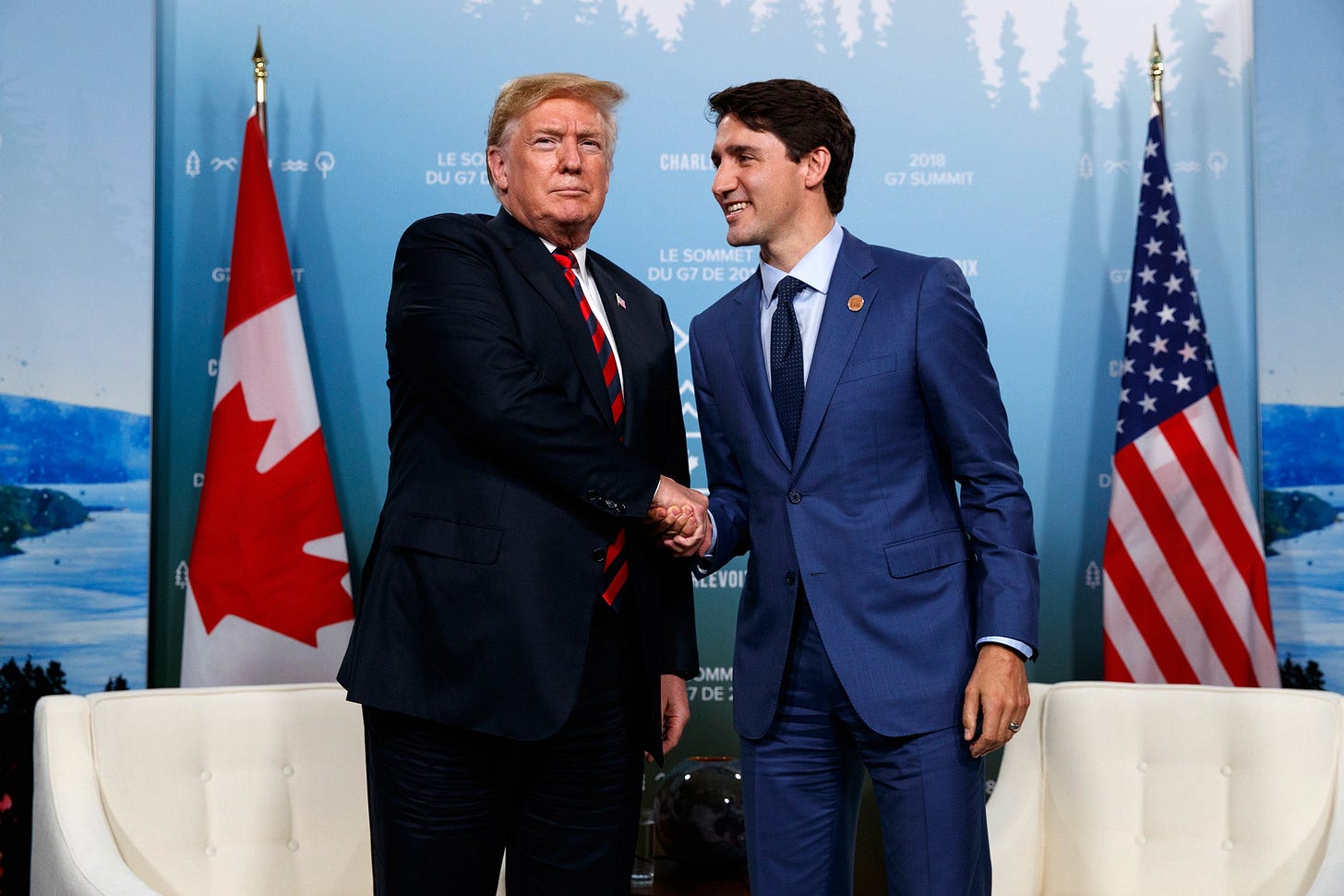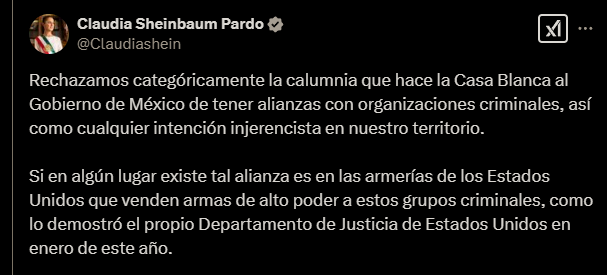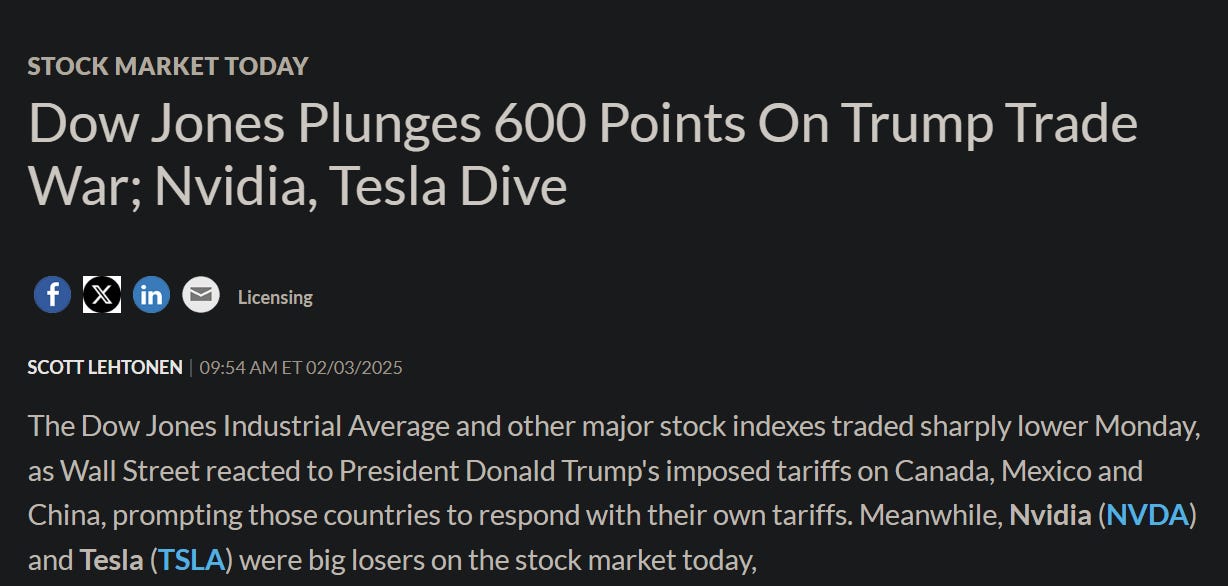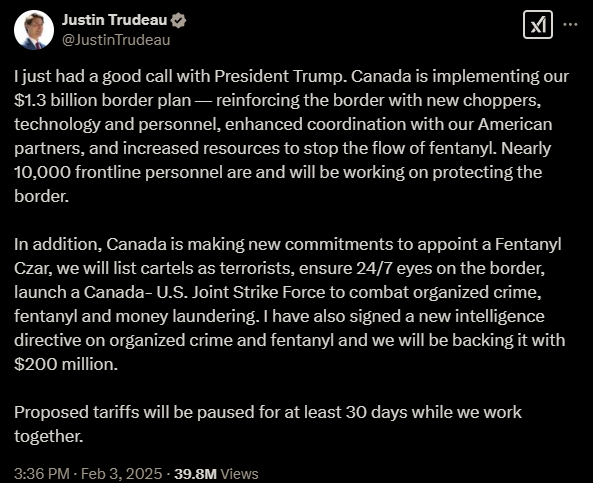The Trump Tariff Wars - Round 1
Who won round one?
This Trump presidency is not unlike the first one, in that he tends to flood you with unlimited things to talk about. It seems to be his prerogative to be on the front page of the newspapers every day. Tariff negotiations between him, Canada, and Mexico were on Tuesday, yet it seems like five months ago.
A lot of people didn’t agree with me on social media, but I think the tariff negotiations could have gone one of two ways, and I’ll explain both of them.
The same day Trump got inaugurated, he announced that 25% tariffs would be slapped on Canadian, Mexican, and Chinese imports starting February 1st. A lot of Trump supporters assured everyone that this was just a negotiating tactic. Trump himself would later dismiss that notion, saying, “No, this is not a negotiating tactic, this is economics,” and cited trade deficits. Trump also previously stated that if these countries retaliated, he would increase the tariffs.
No Days Off
After Trump made this statement over the weekend, Canada responded with its own 25% tariffs and other measures to go into effect at the same time as the Trump tariffs. Canadian president Trudeau surprisingly stepped up to the challenge gave the best speech of his career. Mexico stated they would retaliate but did not give specifics, just that they had a “plan B.” Mexico’s president, Claudia Sheinbaum, kept reiterating that things should be done through reason and not force.
Production
Before we continue, I need to talk about tariffs and some general economics. A tariff is an import tax, and many Americans are not familiar with them because they rarely deal with them directly. In the US, everything you want to buy you can typically find at a store or on an American online store. Citizens of other countries, especially developing ones, often have to purchase items from abroad, so they deal with import taxes more frequently. This means that when 25% tariffs are announced on the US’s two largest trading partners, the general public doesn’t even understand what’s happening.
According to the US Census Bureau, Mexico, Canada, and China account for 41% of US trade. This would mean that if those tariffs went into effect all on the same day, almost half of US imports would cost 10%–25% more. Americans wouldn’t be able to increase their industrial capacity overnight and make those items, so they would just have to eat the costs. Trump would probably get impeached within six months (lol), or at minimum Republicans would get decimated in the midterm elections. This is where we get my first theory: I have reason to believe that Republican politicians and businessmen reached out to Trump over the weekend and explained what would happen if he continued with these tariffs. They got him to back off Mexico and Canada, but they could not get him to remove the Chinese ones.
Americans currently don’t have the capability to significantly increase their industrial capacity. There are four inputs that go into production:
Land
Labor
Capital
Entrepreneurship
The US currently lacks sufficient labor, and they would need investment to acquire all of the machinery. Employment in the US currently sits at around 4%, or 7% if you want to consider a larger pool. That’s not enough people to increase industrial capacity by much. The US can sacrifice the production of one thing for another, but it can’t increase overall production by much. There are potential solutions, like immigration, but the Trump administration is not immigration-friendly. Another is waiting for AI and automation, but these are unknowns and at least a few years away.
D-Day Minus 1
On Sunday night the Dow Jones futures dove down 600 points.
Trump also announced that night that he had calls scheduled with Trudeau and Sheinbaum on Monday. The tariffs were set to go into effect Tuesday at 12:00 am. Some people say he announced this because he saw how badly the markets were sliding, but it’s hard to really know. Correlation is not causation..
The Negotiations
Mexico
The negotiations began Monday morning with Mexico. Keep in mind, Trump was now “negotiating” after he said the tariffs could not be negotiated. After the negotiations were over, Mexico announced it would send 10,000 troops to the border with the US, and Trump delayed the tariffs by 30 days. Mexico has also done this for previous administrations. The Mexican military is continuously engaged in combat against cartels. It’s uncertain how taking some of them away from other regions and placing them in border towns will affect the fight. Another unclear detail is whether it’s 10,000 new troops or if they’re adding 2,000 to the 8,000 already at the border and calling it 10,000.
The gain for Trump in this exchange remains unclear.
Canada
The last negotiation was with Canada later in the day. After the negotiations, Trudeau announced on Twitter:
This first half of that tweet was something the Canadian government already said it would do last December. So what Trump actually got was a Fentanyl Czar, labeling cartels as terrorists, and a Joint Strike Force to combat organized crime, fentanyl, and money laundering.
This is where the second theory comes in: if Trump was actually threatening tariffs to negotiate, he got outplayed by both Sheinbaum and Trudeau. Why? These seem like token gestures. There’s nothing in any of these “deals” that he couldn’t have gotten with a simple phone call. This is also a very inefficient use of force. This would be the equivalent of holding a grenade in your hand, walking up to your neighbor, and saying, “Give me a pen or I’ll blow both of us up.” Your neighbor would give you a confused look and say they would have given you the pen anyway. You didn’t need the grenade.
Round one goes to Mexico and Trudeau because for the threat level they didn’t give up much, Xi Jinping didn’t say a word, and Trump did not increase tariffs on Canada as promised after they retaliated.
Thank you for reading.





